William Lansdon may sport the facial hair of a weathered Jumanji survivor, but don’t let his hard exterior fool you. His personality is quite warm and jovial. A native of Florida’s Big Bend swamplands, Lansdon’s molasses-thick accent has thinned over the years to an inviting drawl that makes him capable of bringing out a smile in just about any conversation. He often spins yarns that captivate an entire room.
And that’s why it’s so jarring when you can feel his heart ache.
Lansdon is the senior program manager for UTSA’s Office of Veteran Military Affairs. In this role, he oversees programming and engagement for UTSA’s student veterans, as well as customer support at the university’s Center for Military-Affiliated Students. He says that when veterans approach him for assistance, they often discuss the symptoms they’re experiencing, but not the root issues. One example will forever echo in his memory.
On this day, he recalls meeting a fed-up Marine combat veteran who was ready to withdraw from the university. Lansdon wanted to help, so he called him back to his office and they talked for 45 minutes. Lansdon listened to him describe his issues and connected him to various resources. None of this may seem particularly remarkable, but when Lansdon thinks about how the conversation ended, tears begin welling up in his eyes.
“You know what the gentleman asked me for? A hug,” Lansdon says, pausing briefly to clear the lump in his throat. “That was it. It was not ‘I need money,’ not ‘talk to my teacher,’ not ‘get me tutoring,’ not ‘help me with my housing’ — those are all things I deal with on a regular basis. All he wanted was a hug and to be told, ‘You’ve got this.’”
He pauses longer this time, closing his eyes and letting the power of that moment wash over him.
“I know what he felt like because I’ve been in that seat feeling how he felt,” he says. “But I didn’t have someone on the other side of that desk saying, ‘Here’s how I can help you. Let me give you that hug.’”
Lansdon has found his life’s purpose in not just serving his fellow veterans, but in transforming how they’re served. He bears the mental and physical scars of being an Iraq War combat veteran, and yet his post-service struggles resonate with him just as much. Lansdon lived for a very long time under the weight of bleak hopelessness.
WATCH THIS VIDEO: Hear from William about his journey and the UTSA Office of Veteran and Military Affairs
He was born and raised in Steinhatchee, Florida, a small and isolated Gulf Coast fishing town. In Lansdon’s own words, he grew up in poverty with a single dad who was an abusive alcoholic. Steinhatchee offered neither a healthy environment nor a prosperous one as he entered adulthood. “You could either work at the prison or work at the mill — and that’s the next town over,” he says.
He saw the U.S. Army as his best — and perhaps more importantly, first — ticket out of town. Lansdon enlisted as a specialist in division support command for the 1st Armored Division. During his four-year enlistment from 2003 to 2007, he was deployed to Baghdad, Iraq, where he worked as a supply clerk in the “motor pool” at a forward operating base at Baghdad International Airport.
Though he has fond memories of his motor pool pals, whether they were staging breakdancing contests or being forced to move sandbags as punishment for goofing off, he has many more that shake him to his core. Lansdon remembers retrieving vehicles after conflicts and spraying his comrades’ blood and guts off the seats. He still thinks about the cars that charged his base’s gate on his first night in Iraq. The atrocities that involved children are the ones he continues to have difficulty discussing.
When Lansdon got out of the military, he was diagnosed with depression, but also struggled with Post Traumatic Stress Disorder (PTSD) that had long gone undiagnosed. On Thanksgiving Day of 2008, seeing only one way to ease the emotional and physical pain he was experiencing, he attempted suicide. Though this attempt was not successful, he continued to spiral for several years.
Eventually, everything fell apart in 2011 and he found himself homeless in the hometown he so desperately wanted to flee. For years, he’d sleep in his car or try to crash on someone’s couch while seeking out odd jobs.
“I spent six months sleeping in a horse trailer,” he recalls, explaining that he met a woman who owned a chrome shop and started doing some work for her. “She couldn’t afford to hire me as an employee, so I stayed in a horse trailer on the back of her property and she basically paid me in food. I showered under a water hose and slept in a hammock in the back of a horse trailer.”
BIRDS UP PODCAST: William recently joined the Birds Up podcast to discuss UTSA’s military-affiliated population
In 2014, a friend helped him get a contract job as a day laborer in Pennsylvania — and that’s when things started to turn around. Lansdon knew this was the first chapter of his second chance. By 2015, he had enough money for a fresh start and he found himself drawn to a new mission to uplift downtrodden veterans. Moving to Military City USA offered him the best path forward. He attended Alamo Colleges for two years and made in-roads with several local veteran organizations. Then, when he arrived as a student at UTSA in the fall of 2017, he quickly sought out a student worker position in the university’s Office of Veteran and Military Affairs (VMA).
Lansdon estimates that he’s had six promotions in the seven years since, working his way up from a peer success partner to a program coordinator to his current role as the senior program manager, overseeing the entire day-to-day operations of the VMA office. According to his peers, Lansdon’s efforts have been instrumental both in fostering an active community of veterans and military-affiliated students and also in providing support that truly reflects their needs.
His input was influential in the creation of UTSA’s Center for Military-Affiliated Students (CMAS), which consolidated VMA, Hazlewood and GI Bill certification, and the VA’s VetSuccess On Campus counselors in a single one-stop location on the first floor of the John Peace Library. Lansdon created and continues to organize the monthly Coffee for Vets event on campus, which has been a huge driver for networking, professional development and community-building among UTSA’s student veterans. He’s also been a key leader in the growth of the university’s veteran resource fair — from a small three-table get-together to a mammoth 40-table event that connects hundreds of student veterans to helpful resources.
All the while, he has continued to assist student vets individually day after day. After years of therapy, Lansdon says he’s become more composed and willing to open up to others, which has only helped him build trust with many of UTSA’s veterans. Michael Logan, ’10, M.Ed. ’11, Ph.D. ’19, UTSA’s senior director of the Office of Veteran and Military Affairs, marvels at Lansdon’s ability to listen, comprehend and act reflexively.
“Will is uniquely gifted at empathy. He can identify the needs and trends pretty easily, almost like being able to pull the code out of the matrix and see the big picture,” Logan says. “He is super, super focused on becoming the best at what he does, which is engagement and outreach for veterans.”
Now that he’s in a healthy marriage to a loving wife and is the father of two sons, Lansdon aims to be a catalyst for the kind of change that he’s experienced. Ten years ago, he was a homeless veteran who felt he had no purpose in life. Today, the VA calls him directly to ask for programming guidance. Reflecting on his transformation brings a proud, slightly wry smile to his face. He’s grateful that UTSA has given him the agency to help transform the way the university’s student veterans are served, which is more reflective and less prescriptive than its peers. He hammers that point home to everyone who visits.
“For me, it’s not enough to just change things here at UTSA,” Lansdon says. “My ultimate goal is to change the way higher education looks at this population and supports this population.”
THE CASCADE EFFECT
With a consolidated model, a one-stop center and a culture that emphasizes reflective empathy, UTSA has emerged as a national model for its support of military-affiliated students
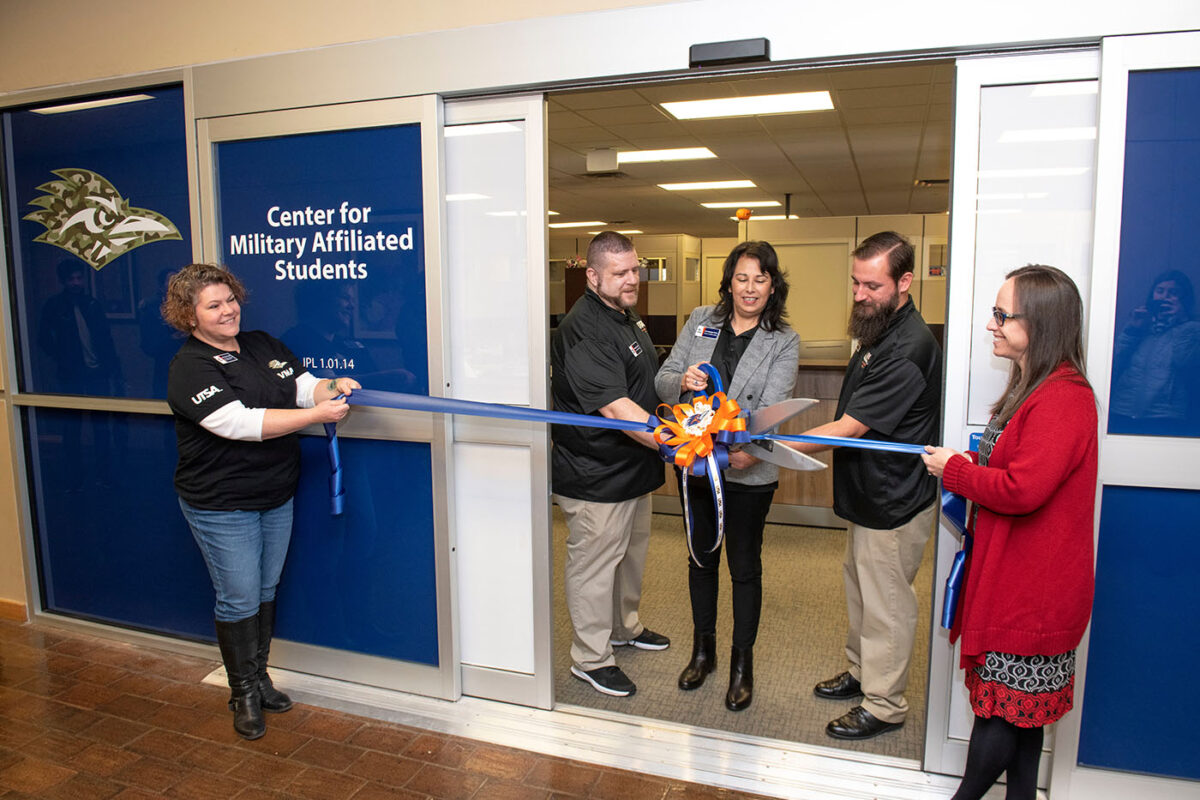
Col. Lisa Carrington Firmin can attest that there’s tremendous value in failure.
Years before the Office of Veteran and Military Affairs (VMA) existed at UTSA, she was serving as the founder of the Top Scholars program and meeting with the university’s Veteran Services Advisory Committee. As part of that ad-hoc team, she put together a grant proposal for the U.S. Department of Education to essentially create a consolidated support center for UTSA’s student veterans.
She worked very hard on the grant proposal even though she knew it had no realistic chance of being approved. It wasn’t. But the work she put in and the feedback she was given planted the seeds to create the VMA office and a Center for Military Affiliated Students at UTSA.
Once she was named the associate vice president for veteran and military affairs at UTSA, Firmin got to work repackaging the plan with student voices and needs assessments. Then, she, Lansdon and former program coordinator Micah Wright met with President Taylor Eighmy to get his buy-in. Firmin says that he was receptive and encouraging. He, too, wanted to provide comprehensive support for a student population that had long been underserved on college campuses.
“I think there’s a prevailing bias that the veteran population is less engaged — that they don’t do as much or they don’t want as much or they’re not on campus as much. But in reality, they’re very engaged,” says Michael Logan, ’10, M.Ed. ’11, Ph.D. ’19, who became UTSA’s senior director of the Office of Veteran and Military Affairs in September of 2020. “They just needed something that was geared more toward them so they could engage with it effectively.”
This was especially important at UTSA, where veterans represent 7% of the student body and military-affiliated students (which includes active duty, ROTC and military family members) make up 16%. Needless to say, standing up a new center that brought together all military-affiliated services under a single administrative umbrella would be a big undertaking. But it was certainly a worthy one.
The Center for Military Affiliated Students (CMAS) opened in November 2019. Since then, UTSA’s military community has been able to network, socialize, discover benefits and more easily navigate the university. They’ve enjoyed innovative programming, such as priority registration and tailored orientation for veterans, as well as professional development and wellness workshops. Behind the scenes, VMA has also collaborated with other UTSA departments such as Financial Aid, Fiscal Services and the Office of the Registrar to create back-office processes that improved accuracy, speed and made the experience more seamless for military-affiliated students.
It wasn’t long before other institutions were looking to UTSA to amend — or even drastically revamp — the way they served their veteran populations.
“The fact that public universities and smaller private schools from around the nation are spending their money to come tour our facility and examine our model to take it home tells me we’re doing something right,” says William Lansdon, the senior program manager for the VMA office.
“We were the first university in the UT System to create this consolidated service model, and people took notice and started coming to us,” adds Firmin, a Bronze Star Medal recipient who retired from the U.S. Air Force as its most senior-ranking Latina officer before arriving at UTSA. “We became subject matter experts for student veteran culture and their sense of belonging. We became a go-to with direct lines to the VA. We had connections and we were respected on a national level.”
VMA leaders have even provided reviews and feedback for military student success centers at other institutions. When a university was selected to give a presentation about veteran cultural competency to behavioral health professionals at a conference in Tuscon, Arizona, in the summer of 2023, it was not the University of Arizona, Arizona State University or any other institution in the Pacific or Mountain time zones — it was UTSA.
Military-Affiliated Roadrunners By The Numbers
NO. 1
UTSA has the largest population of military-affiliated students in the UT System
3.09
The average GPA of military-affiliated students at UTSA (0.08 higher than full-time undergraduate average)
16%
of UTSA's student body (roughly 5,000 current students) are military-affiliated
7%
of UTSA's alumni are veterans of the U.S. armed forces
However, Logan is quick to point out that UTSA’s success in serving military-affiliated students doesn’t stem from a facility or a consolidated service model. It’s the culture that shines through. Every staff member in the office is either a veteran or the family member of a veteran. All but one have been UTSA students using their military benefits. They’ve fully embraced an approach that always puts the student veterans first.
“We need to figure out where they are, meet them where they are, and then we can guide them to where we think they need to go,” Logan says. “We had to put away that whole ‘if you build it, they will come’ mentality and instead build relationships and trust.”
The results speak for themselves. In a higher ed landscape awash with student-veteran stopouts, dropouts and poor performances, UTSA’s military-affiliated students have achieved a higher average GPA (3.09) than their undergraduate peers (3.01).
But there’s so much VMA’s staff still wants to accomplish. Fresh off of five months with the George W. Bush Institute’s Stand-To Veteran Leadership Program, where he learned from a variety of nationally-known and distinguished experts in veteran transition and leadership development, Logan wants to cultivate the next generation of thought leaders for veteran service organizations. As part of that effort, he’s mentoring researchers in a variety of veteran-related subjects and is currently working to launch a student veteran research summit at UTSA, where students could present about topics such as fostering a veteran’s sense of belonging, positive psychological approaches to treating veterans and gender disparities in veterans using their GI Bill benefits.
“If I can influence those individuals, and they pay that forward, it just starts a cascade effect,” Logan says.
GUIDING HANDS, CALMING PAWS
With the help of the UTSA’s Office for Veteran and Military Affairs, Air Force combat veteran Eloy Rodriguez ’21 worked through several personal issues, put himself on a path toward a successful career and found a much-needed companion
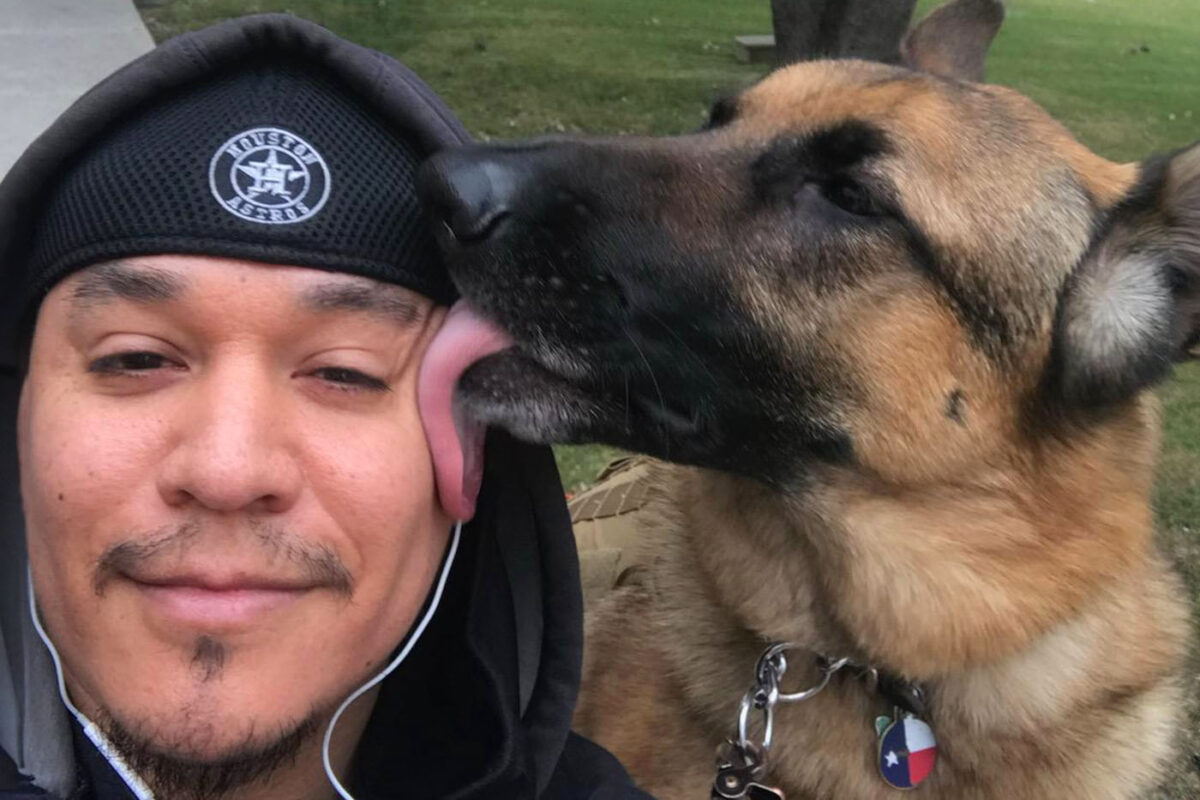
Eloy Rodriguez ’21 is still settling into his new life in Reno, Nevada. He recently left a position as a software engineer for General Motors in Austin and made a major cross-country move to take a new gig working for the cyber division of the VA Office of Information and Technology. Now, he not only enjoys an environment where he gets to work alongside many fellow veterans, but also revels in the various challenges of tinkering with code on laptops, servers and other devices. “It’s a whole playground,” he says with a big smile.
No one — not his family, not his friends, not his peers, not even Rodriguez himself — could have imagined this outcome six years ago. At that time, he could barely walk down a public hallway without experiencing some iteration of a panic attack, much less live independently 1,700 miles away from his hometown.
“I didn’t see me graduating or having a career. For a long time, I didn’t see me living past 18,” he admits. The number of times he thought he wouldn’t live past a certain age seem to be endless.
Rodriguez was born and raised on the West Side of San Antonio. Growing up, he has fond memories of escaping those surroundings to attend East Central High School and kindling his passion for electronics by rewiring an enormous record player console. However, there are many more memories he’d rather not mention or even think about.
“It was all gang territory,” Rodriguez says. “I got in the service to get away. My mom wanted a different direction for me.”
Rodriguez enlisted in the U.S. Air Force in the fall of 1999 and would spend the next 15 years of his life serving his country in Afghanistan, Iraq, Qatar and Kyrgyzstan among others. As an electrical systems craftsman, his main focus was base sustainment, setting up the electrical grid that an entire base would depend on. He often dealt with extremely high voltage and did so in perilous situations. Death and danger were unfortunate but constant companions throughout his time in the Air Force.
His final years in the service, however, were arguably among his worst. Shortly after his uncle was diagnosed with Stage 4 Lymphoma, which he survived, and bone cancer took his cousin’s life, Rodriguez was diagnosed with Seminoma and forced to return to San Antonio. Once he was considered a liability to the military, his career in the Air Force abruptly ended in 2015.
For the next two years, he endured cancer treatments he can only characterize as “extremely rough” in addition to two stints in rehab as he struggled with combat PTSD and his transition back to civilian life. Even as he reached remission, he felt aimless. The structure of the military was all he had known for his entire adult life, and like many longtime veterans, he struggled to adjust to independence.
“Lost. Unworthy. Hopeless. Numb. Confused. Abandoned,” Rodriguez describes his feelings at the time. “I knew I was walking, but I was walking with no light to show me the way. It was a very, very hard transition.”
Rodriguez’s first semester at UTSA was a stressful one. As a seasoned 30-something combat veteran who had lived through so much, he didn’t feel like he could relate to the younger students that populated the majority of his classes. He was also staring down a fear he hadn’t experienced in nearly two decades: The anxiety of writing school papers. So, Rodriguez joined VMA’s Veterans Writing Group to get some assistance. Through those meetings, he not only improved as a writer (so much so that he aced his freshman composition class), but found a community of veterans with whom he shared a culture and an unspoken understanding.
He also found a true confidant in William Lansdon, who helped organize the writing group as a student worker. Just like Rodriguez, Lansdon was new to UTSA. Just like Rodriguez, Lansdon had struggled with PTSD and his transition back to civilian life. Lansdon was someone Rodriguez knew he could depend on.
“There’s a cursory sense of trust that you put into another veteran because of your shared experiences,” explains Lansdon, who’s now the senior program manager for the VMA office. “That gives me the opportunity to have conversations with these students that other people can’t necessarily have.”
That trust faced its toughest test more than a year later when Lansdon strongly urged a reluctant Rodriguez to get a service dog. Trained to respond to the verbal and non-verbal cues of their handlers, service dogs can act as both a source of social support and a behavioral mirror for veterans dealing with the symptoms of PTSD. Lansdon felt a service dog could block for Rodriguez when he was anxious in social settings and comfort him during oncoming panic attacks.
Rodriguez, on the other hand, couldn’t imagine adding canine care to his extensive list of stressors: “I told him, ‘I can’t afford no dog. I’m not working. I’m going to school full-time and I live in a one-bedroom apartment.’ There was a lot going through my head.”
When Lansdon’s wife tracked down a service dog that was available, Rodriguez begrudgingly and noncommittally agreed to go meet the dog. But when Lansdon drove to the trainer’s facility and parked, Rodriguez wouldn’t get out. Panic had set in. His feet were colder than Christmas in Quebec.
“I looked him dead in the eye and said, ‘Get out of my car. We’re going up there and I’m not taking ‘no’ for an answer,’” Lansdon recalls. “‘I’ll go up there with you. We’ll do this together. But get out of my car.”
His hesitancy quickly gave way to happiness. From the moment the dog came out, those two were inseparable. “Nobody else existed to Eloy for the next 40 minutes,” says Lansdon, who lights up as he relives the moment. “For those 40 minutes, nothing else mattered — not his anxiety, not Iraq, not his past — but him and Max.”
“When he chose me, we were immediately attached,” Rodriguez admits. “He wouldn’t leave my side and he hasn’t since.”
Max has been nothing short of a blessing to Rodriguez. Max wakes him up when he’s having night terrors. Max knows to engage with him when he sees his hands are shaking. In crowds, Max creates space between Rodriguez and others. Most importantly, Max has provided constant companionship to someone who long felt alone, unwanted and abandoned.
“The things I struggled with before — the things a normal person does regularly — I’ve just about gotten back to them because of Max,” Rodriguez says. “He’s helped me with just about everything.”
In turn, Rodriguez has made every effort possible to care for Max with the same kindness. So, when the A/C went out in his old clunker of a car in 2019, Rodriguez knew it was a problem. He also knew the car was nearing its demise, so he went to Lansdon and the VMA team to see if they could offer any assistance. They reached out to the Progressive Keys to Progress program, which has now gifted over 1,000 vehicles to veterans across the country. Rodriguez then penned an essay about his need for a new vehicle to get to his classes at UTSA and to keep his hairy, 100-pound companion cool during those scorching San Antonio summers.
Those Veterans Writing Group sessions paid off again. It wasn’t long before Progressive gave Rodriguez a new Toyota Camry packed to the gills with lots of extra goodies.
“They filled the car up with doggy stuff — a bed, multiple toys, a couple of blankets, gift cards for PetSmart and Petco, dog food. And then they gave me $2,000 in gift cards for groceries and gas,” Rodriguez says with a bewildered chuckle. “I still haven’t used all of the gift cards yet.”
Rodriguez credits VMA for hooking him up with several helpful resources throughout his experience at UTSA, such as job leads, career-focused workshops, resume-building resources and even a music therapy class for his anxiety issues.
Graduating from UTSA was one of the proudest moments of Rodriguez’s life, and it was quite memorable for many of the strangers who filmed TikToks of him crossing the stage at the Alamodome that day in December 2021. After all, it’s not often that you see a graduate earn his degree alongside a German Shepherd in a matching cap and gown. Rodriguez knew he’d need Max by his side to get through Commencement. After walking through the curtain, Rodriguez stared intently into the crowd to blow a kiss to his mom and dad, Norma and Jerry Espinoza, and the rest of his family. And when Max noticed his human was getting a bit too nervous, he went to work.
“When we came out, everyone applauded. But when Max stood up and gave me a hug, the crowd went ballistic,” Rodriguez says. “It was pretty hard for me to walk the stage. Usually, in that type of environment, it’s a lot for me to take in. But Max helped calm me down.”
WATCH THIS VIDEO: Relive the moment when Eloy and Max crossed the stage at Commencement in 2021
What the crowd didn’t see was VMA Director Michael Logan ushering Rodriguez to a safe room afterward to get him away from the celebratory fireworks that could have triggered PTSD-related symptoms. Rodriguez can’t help but commend VMA for always going the extra mile for UTSA’s military-affiliated students. As he sits and reflects on his time as a Roadrunner in Reno, he knows their support helped him realize his greatest potential.
Lansdon knows from personal experience that Rodriguez’s transformational journey will ripple far beyond just his life.
“To see that change — that’s huge. Eloy now has a great job, and if he gets married and has children, his children will have a better life with more opportunities. And then his children’s children,” Lansdon says. “I don’t want to overstate it, but we’re changing generations for the better.”
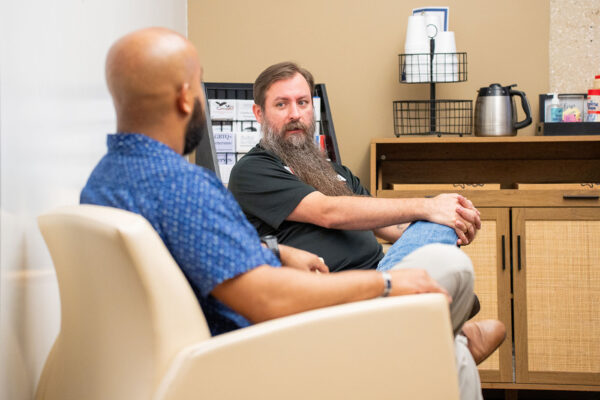
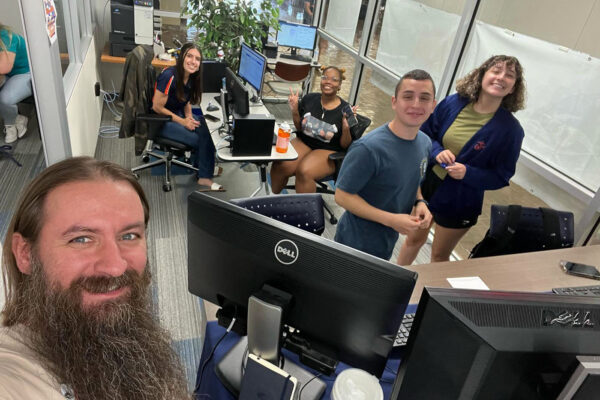
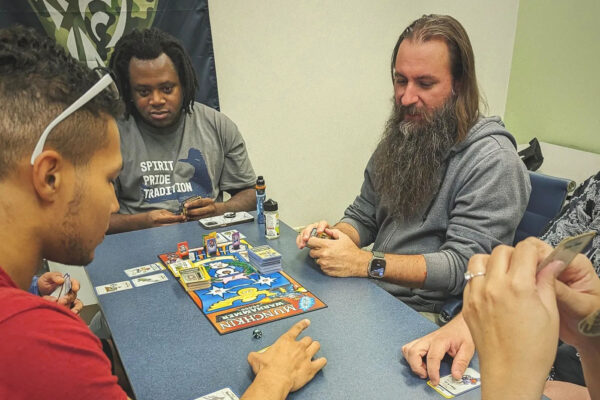
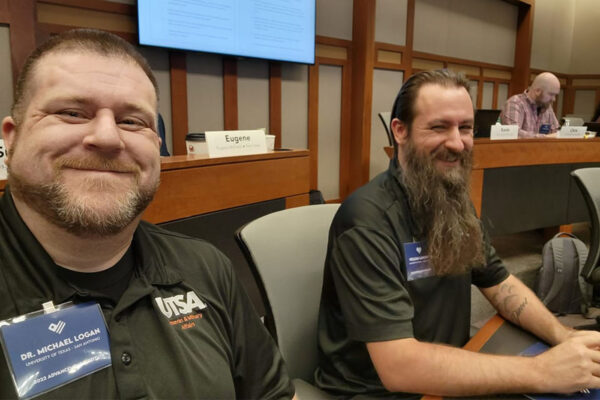
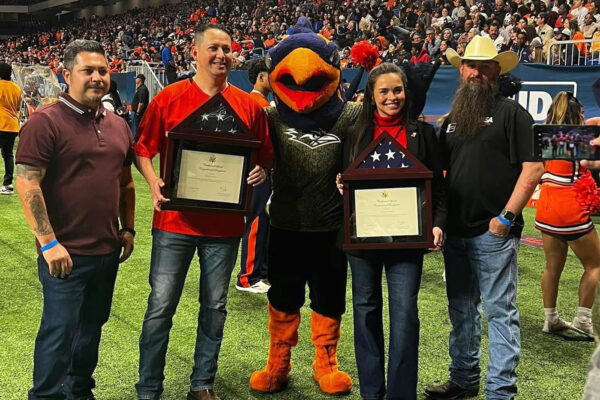
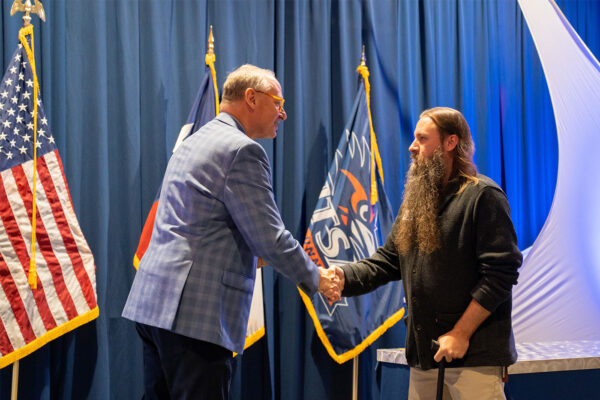
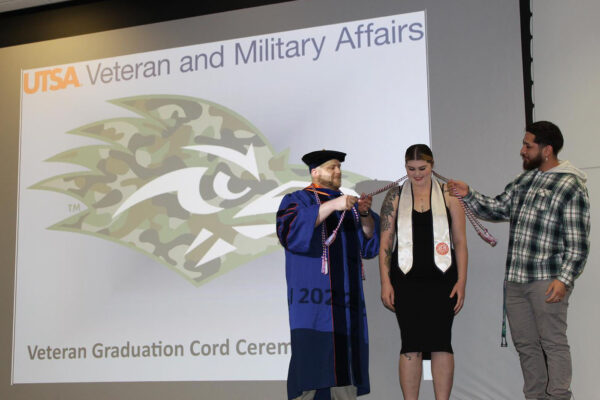
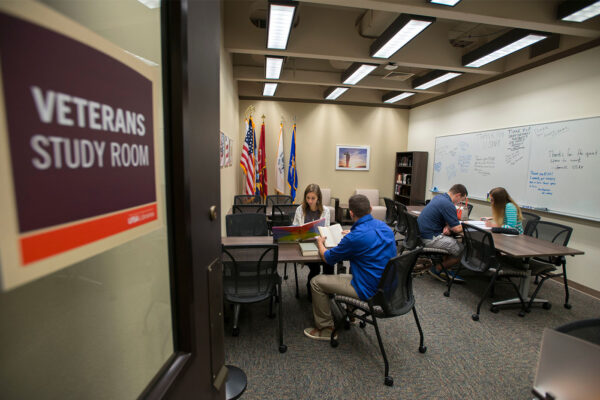
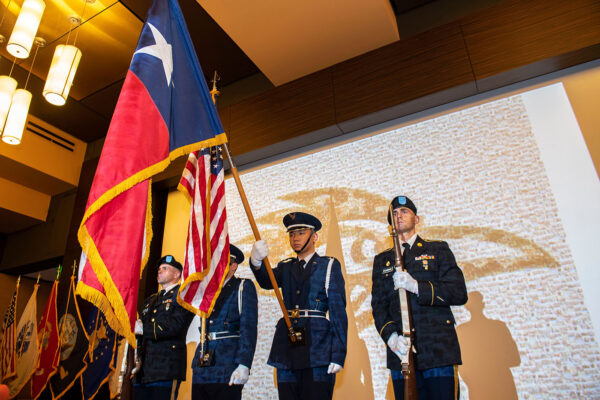
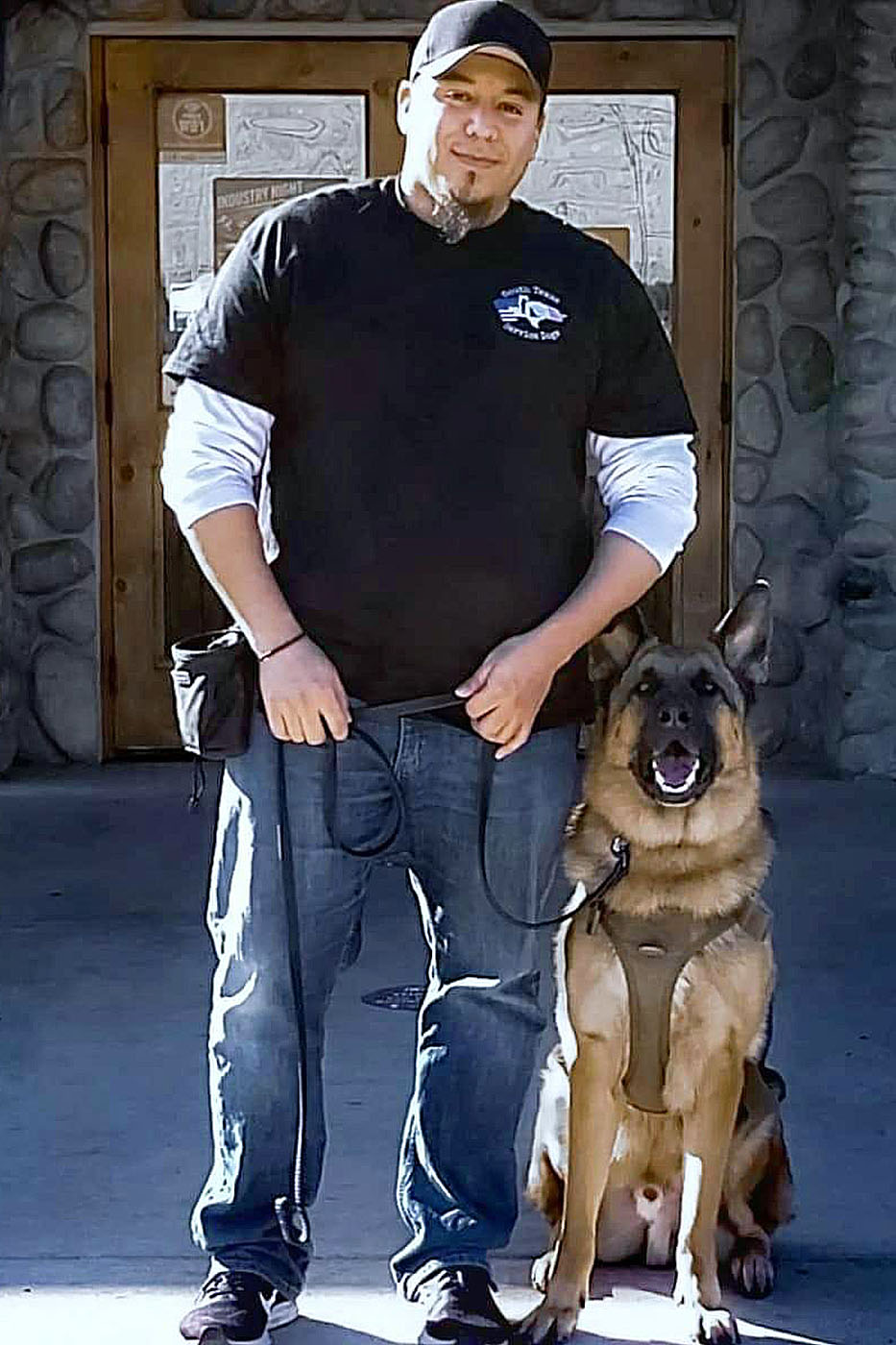
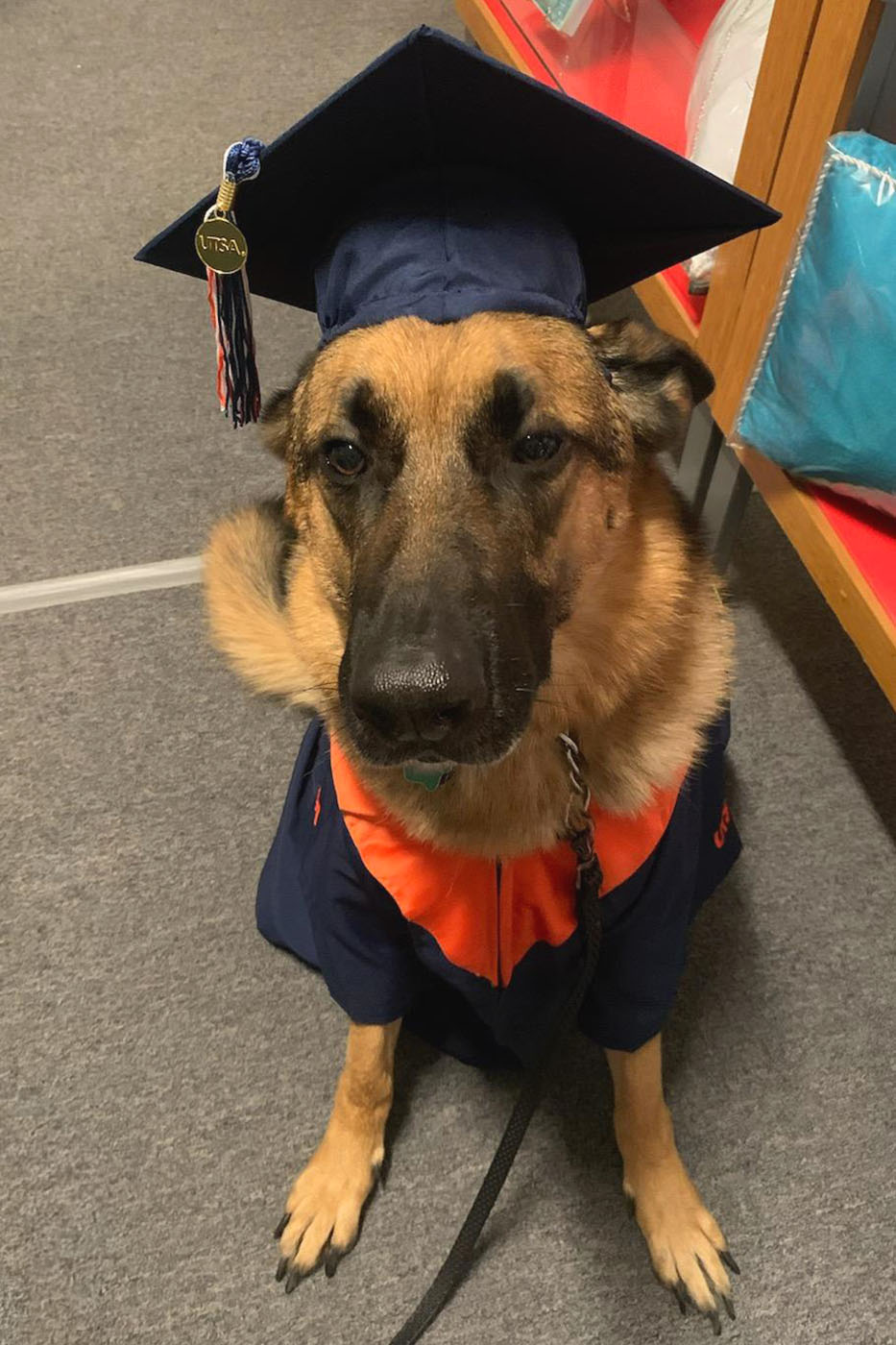



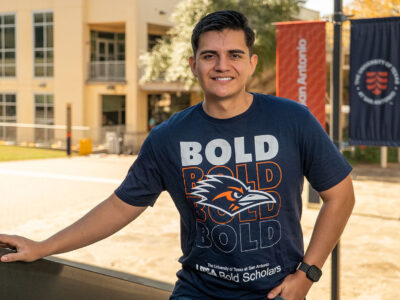
No comment yet, add your voice below!